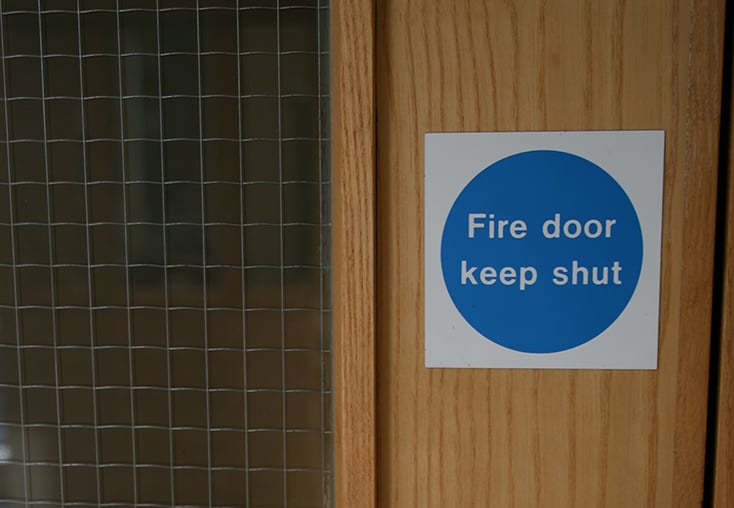Fire Doors
Fire Door Safety Week (25-29 September)
What’s so important about Fire Doors?
In short, fire doors save lives and property. They are part of a building’s passive fire protection system and are fundamental to most fire strategies for buildings.

Fire doors are often the first line of defence in a fire especially when we are asleep and at our most vulnerable. Their correct specification, installation, maintenance and management can be the difference between life and death for building occupants.
Despite this, fire door breaches remain one of the most common fines implemented under the Fire Safety Order, with common problems ranging from doors being wedged open, missing or damaged doors or even non-fire doors being installed in their place.
As part of the Fire Kills campaign, Hereford & Worcester Fire and Rescue Service is supporting Fire Door Safety Week 2025 and encouraging building managers, landlords, tenants and all building users to check the operation and condition of their fire doors and repair (if possible) or report those that aren’t satisfactory.
Group Commander Deb Davies from the Protection department at Hereford & Worcester Fire and Rescue Service, said: “It cannot be underestimated the difference that an effective fire door can make. A fire door is not always a fire exit door and is typically identified by a blue ‘FIRE DOOR KEEP SHUT’ sign often at eye level.
“Fire doors are an essential part of our fire protection, they help to compartmentalise a building, such as a block of flats, keeping fire and smoke trapped for a while in one area, so that the fire can be tackled, and people can be safely evacuated.
“If you’ve seen a damaged fire door or know of a flat entrance door that hasn’t been checked for fire performance, report it to your landlord or building manager straight away and if you see a fire door propped open, make sure you shut it – a fire door cannot work when open.”
5 Step Fire Door Check
Fire Door Safety Week is giving these tips for a 5 Step Fire Door Check that anyone can do, and which lets you know whether it’s time to call in the professionals:
Check for certification – Is there a label or plug on top (or occasionally on the side) of the door to show it is a certificated fire door?
Check the gaps – Check the gaps around the top and sides of the door are consistently less than 4mm when closed.
Check the seals condition – Are there any intumescent seals around the door or frame, and are they intact with no sign of damage?
Check the hinges – Are the hinges firmly fixed (three or more of them), with no missing or broken screws?
Check the door closes properly – Open the door about halfway, let go and allow it to close by itself. Does it close firmly onto the latch without sticking on the floor or the frame?
For more details, visit www.firedoorsafetyweek.co.uk.
Anyone who thinks they might qualify for a free Home Fire Safety visit can call the HWFRS Prevention team on 0800 032 1155.
People can complete a free online Home Fire Safety check at www.safelincs.co.uk/hfsc/
What do fire doors do?
They provide critical protection within a building such as escape routes (stairs and corridors) and places of relative safety, and in separating different fire hazards in a building.
Specific guidance for fire doors relating to all buildings which contain two or more domestic premises and that contain common parts through which residents would need to evacuate in a fire is available on the www.gov.uk website:
Important information about fire doors
- Fire doors must work correctly
- They must be tested and third-party certificated to BS 476 – – Part 22 or BS EN 1634 Part 1
- They must be fitted with the correct and compatible components suited to the door leaf and its purpose
- Like any fire safety device, they should be installed and maintained by competent people
- A fire door’s performance should never be compromised
- Correct glazing and ironmongery must be used
- No altering or adapting the door leaf on site
- Always use the correct frames
- Always use intumescent seals
- Ensure good installation and maintenance
- Never prop open a fire door
DOs and DON’Ts for staying safe
Dos
- Specify and use third-party certificated fire doors and components
- Buy fire doors, frames and components from certificated companies
- Check the certificate matches the door
- Make sure you have the correct certification for the door’s intended use
- Install and maintain fire doors using competent personnel
- Make sure that ironmongery components are CE marked.
Don’t
- Fit a fire door as you would any other door – it’s an engineered safety device
- Cut vision panels and other holes on site
- Patch up a fire door
- Take risks by reducing the specification
- Disconnect a fire door closer
- Prop or wedge open a fire door
Did you know?
- Leaving fire doors wedged or propped open disregards the safety of others. Fire doors serve a vitally important purpose preventing the spread of fire to escape routes which allow people the time to evacuate the building safely.
- All fire doors should be fitted with intumescent seals – they expand between five and ten times their original size, sealing the gaps around the perimeter of the door and holding the door construction firmly in place.
- Some fire doors may also need smoke seals and/or acoustic seals.
- Essential ironmongery for fire doors must be CE marked even though fire doors themselves don’t need to be (at present).